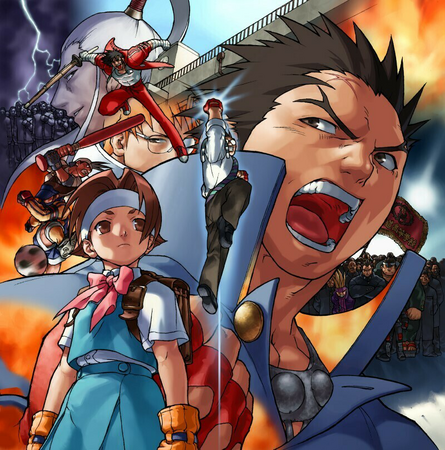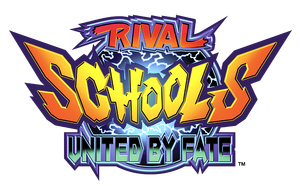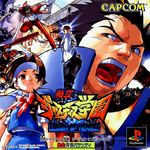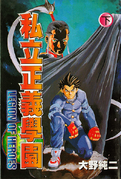Rival Schools: United By Fate (Shiritsu Justice Gakuen: Legion of Heroes 私立ジャスティス学園 LEGION OF HEROES | lit. "Justice Private Academy: Legion of Heroes") is a fighting game made by Capcom, released in arcades in 1997. It focuses on a large cast of students and teachers from various schools duking it out in their fight for justice. It is the first game in the Rival Schools series and it takes place in 1997 Japan, the same year this game was released.
Despite having been rather obscure, the game is now known for being very plot-heavy for the genre, where storylines are usually ancillary and disposable. The game features a story mode with dialogues advancing the story before and after fights, and includes a secondary, non-fighting mode that reveals additional details about the characters and their lives. It was followed by a sequel, Project Justice. Character and promotional art by Edayan. A two-volume manga was published in 1998, followed by a comic mini-series by UDON in 2006.

HD Rival Schools Intro
Intro (HD)
Story
The story introduces the player to a Japanese city called Aoharu City, where several local schools are the victims of unknown attacks and kidnappings of students and staff. The various characters in the game set out to find who is responsible for the attacks on their school, with the cut-scenes and fights portraying their interactions with the other schools and among themselves. Eventually, the story reveals that an elite school in the city, Justice High, is responsible for the attacks. The player's team eventually faces off against Raizo Imawano, the principal of the school, and first boss of the game. If certain requirements are met during the fight against Raizo, the story continues and the players play a last fight against Hyo Imawano, Raizo's nephew and the true mastermind behind the events of the game.
The structure of the single player game of Rival Schools varied depending on how characters were selected. If two characters from the same school were selected (with a few exceptions), single-player would play in a progressing story with fights predetermined beforehand and each fight preceding and ending with short 2D cut-scenes to explain the story. If two characters from different schools were chosen, the single-player mode would instead play similar to other fighting games, with the player's chosen team fighting against random teams of opponents before facing the boss. In the arcade, character selection was initially limited to selecting two characters from the same school and free selection of any character was accessed through time; the PlayStation versions, which included all characters unlocked by default, had no such restrictions.
Characters

Japanese Cover Art
| Fighters | School | Info |
|---|---|---|
| Batsu Ichimonji | Taiyo High School | The lead character of the game. A recent transfer to Taiyo High, he is looking for his kidnapped mother. |
| Hinata Wakaba | Taiyo High School | A first-year student at Taiyo. She immediately joins Batsu in the investigation of his mother's disappearance. |
| Kyosuke Kagami | Taiyo High School | A first-year student and member of the school's morals committee. He too joins Batsu in his investigation. |
| Hayato Nekketsu | Taiyo High School | First appears in the Playstation port of the game. A PE teacher from Taiyo, he seeks out the persons responsible for the attacks in order to help his students and to watch over them. |
| Ran Hibiki | Taiyo High School | Appearing only in Nekketsu Seisyun Nikki 2, she is a journalist for the Taiyo student newspaper looking for a scoop on the kidnappings and attacks. |
| Chairperson (Iincho in Japan) | Taiyo High School | First appears in Hinata's ending in Rival Schools, notifing her of their classmates being inspired by Hinata to take up martial arts. In the ending, Chairperson is referred to as Class Leader. The School Life mode in Rival Schools expands on her character a bit more (though without mentioning her real name). She makes her first playable appearance in Project Justice, working together with Ran and the students of Pacific High School to find out the cause of the recent school violence. |
| Shoma Sawamura | Gorin High School | A baseball player for Gorin High. He seeks out the people responsible for injuring his older brother, Shuichi. |
| Natsu Ayuhara | Gorin High School | A volleyball player for Gorin. Like Shoma, she seeks the people responsible for hurting her junior high pupils. |
| Roberto Miura | Gorin High School | A soccer player for Gorin. He helps Shoma and Natsu in their pursuit, as well as serves as mediator for arguments between the two. |
| Nagare Namikawa | Gorin High School | Appearing only in Nekketsu Seisyun Nikki 2, he is a third-year student and swimmer for Gorin High. He investigates the incidents on his own, as well as keeping tabs on Shoma. |
| Akira Kazama | Gedo High School | A first-year student and new transfer to Gedo High who claims to be the younger brother of the school's gang leader. Akira is later revealed to actually be his younger sister. |
| Eiji "Edge" Yamada | Gedo High School | A student at Gedo and member of the school's gang. He is one student that joins Akira in searching for the gang boss. |
| Gan Isurugi | Gedo High School | A heavy-set student at Gedo and member of the school's gang. Like Edge, he helps Akira in searching for her brother. |
| Daigo Kazama | Gedo High School | Appears as non-playable supporting character in Akira's ending in the arcade version and as a playable character in the PlayStation version. The leader of Gedo's student gang, he cares much for his hometown and seeks the persons responsible for the attack to extract vengeance on them. |
| Roy Bromwell | Pacific High School | A foreign exchange student from the United States. He is investigating the attacks and kidnapping at the request of his father. |
| Tiffany Lords | Pacific High School | Another American foreign exchange student, and a cheerleader. She follows Roy in his investigation, not only to help solve the case but also impress him. |
| Boman Delgado | Pacific High School | A foreign exchange student and preacher-in-training. He joins Roy and Tiffany to help solve the case, although the fighting conflicts with his moral beliefs. |
| Hideo Shimazu | Justice High School | A Japanese language teacher. He is recruiting new students for Justice High at the request of the school's principal. |
| Kyoko Minazuki | Justice High School | Justice High's school nurse (later, science teacher). She is asked to join Hideo in recruiting students to the school. |
| Raizo Imawano | Justice High School | The principal of Justice High. Appears to be the mastermind of the kidnappings and attacks on other schools. He is later revealed to be Batsu's father and the uncle of Kyosuke and Hyo. Appears as mid-boss, and is selectable in Playstation versions or in the arcade by time release or code. |
| Hyo Imawano | Justice High School | A student at Justice High. He is the true mastermind behind the events of the game. He appears as the final boss, and is selectable in Playstation versions or in the arcade by time release or code. |
| Sakura Kasugano | Tamagawa Minami High School | A crossover character from the Street Fighter games. Childhood friends with Hinata and Natsu, she helps them in finding the people responsible for the school kidnappings and attacks. |
Extra Characters
The original Japanese version featured a character edit mode. It was removed in the U.S. version. Instead, the character designs and facial expressions were used to make the 24 "extra" characters. For example, the females from Gorin have the same exact outfit and hairstyle, but one may have a smiling face and another a frowning face. Here is the list of characters in the order of which they are unlocked:
| Rika (Taiyo) | Will (Pacific) |
|---|---|
| Koji (Gorin) | Aki (Aki) |
| Jill (Pacific) | Saki (Gorin) |
| Ben (Pacific) | Saya (Taiyo) |
| Taku (Gedo) | Amy (Pacific) |
| Goro (Gorin) | Yuji (Taiyo) |
| Mai (Gorin) | Eric (Pacific) |
| Maya (Taiyo) | Sho (Gedo) |
| Judy (Pacific) | Taro (Gorin) |
| Hide (Taiyo) | Eri (Gorin) |
| Ban (Gedo) | Beth (Pacific) |
| Jiro (Gorin) | Teru (Taiyo) |
Gameplay
The main fighting game is best described as a 3D Marvel vs. Capcom game, with some notable differences. Control wise, the game varies from other Capcom fighting games by only having four buttons (two punches and two kicks, which is closer to the SNK game format) rather than the standard six. A player chooses a team of two characters, and fights against another two character team. The actual fights, however, are one-on-one fights, with the partner only participating by being called in when a player has enough 'vigor' for a Team Up attack, done by pressing a punch and kick button of the same pressure. The Team Ups would be some kind of double team attack by the character and partner, or (for most female characters' Team Ups) would heal the main character or give them more vigor. After the end of a round, a player (win or lose) has a choice to fight the next round with the partner from the previous round, or to keep their main character in play. The 'vigor' meter (essentially a super meter) could go up to 9 levels, with Team Ups costing two levels and super moves from a single person all costing one level of vigor. Much like the Marvel vs. Capcom games, launchers can be done that allow air combos to be performed, with all characters having universal low and high launchers.
The game also had a few defensive techniques.
- Tardy Counters acted much like Alpha Counters from Street Fighter Alpha, allowing a player to immediately counter-attack from a blocking position. However, the restrictions on Tardy Counters are very lax; any hard normal, special or super attack can be used to Tardy counter (Alpha counters are only limited to certain special moves for each character), and Tardy Counters do not cost any extra vigor to perform (Alpha Counters required at least a level of Super Combo gauge to do).
- Attack Cancels allowed a player to cancel an incoming hit simply by timing their own hit with the attack, which would cancel out both attacks (though it does not nullify the remaining hits of a multi-hit move).
Update and Sequels
Nekketsu Seisyun Nikki 2 Cover Art
Evolution
After its initial arcade release, the game was ported to the PlayStation. The PlayStation version of the game came in two CDs. The first disc included the original arcade game and the standard modes included in most home versions of fighting games. Capcom enhanced the original game with animated introduction and ending sequences, as well as adding voice-over to the story mode in single player. The conversion also added two new characters, Hayato Nekketsu (a hotheaded physical education teacher) and Daigo Kazama (a teenage gang leader and the elder brother of Akira, who was a non-playable supporting character in the arcade version).
The second disc, named the Evolution disc, featured several new games to complement the arcade original. This disc included several minigames based on some of the students' activities and the "Nekketsu Seisyun Nikki" mode, a character creation mode in the form of a date simulation. In this mode, a player would be able to create a student and go through a typical school year. Over this time, the custom character could develop friendships with any of the characters at the various schools, which allowed to give the custom character moves and reveal bits and pieces about the existing characters and their backgrounds. Once the custom character was finished with the school year, it could be used in any of the normal fighting modes, save for the original Arcade game.
Capcom translated most of the games on the Evolution Disc for the English localization, and planned to include the character creation mode (rebranded as "School Life") as well, but unfortunately later abandoned the character creation mode, citing the amount of time it would take to translate it from Japanese to English. The rest of the extra modes featured on the Evolution disc were still included in the overseas versions.
Nekketsu Seisyun Nikki 2
In Japan, Capcom released a PlayStation-exclusive update to the original Rival Schools (Shiritsu Justice Gakuen: Nekketsu Seisyun Nikki 2 私立ジャスティス学園 熱血青春日記2 | lit. "Justice Private Academy: Fighting Spirit Diary 2"). The game featured two additional characters, Ran Hibiki of Taiyo High School and Nagare Namikawa of Gorin High School, as well a new version of the "Nekketsu Seisyun Nikki" school sim mode, which feature additional mini games and further plot developments over the original Japanese version of Shiritsu Justice Gakuen.
Project Justice
A sequel, Project Justice (Moero! Justice Gakuen in Japan), was released in 2000 in Japan and 2001 in the United States and Europe for arcades and the Sega Dreamcast. In comparison to Rival Schools, Project Justice featured teams of 3, adding three-person team-up attacks and the ability to interrupt and stop 2-person team-ups. Like the previous game, Project Justice included a character-creation mode that came in the form of a virtual board game. This creation mode also was never released outside of Japan due to localization issues.
See also
Credits
PlayStation Version
Planner: Hideaki Itsuno, Tatsuya Nakae, Yuji Matsumoto, Takayoshi Terada, Katsuhiro Eguchi, Junko Nonda
Assistant: Daisuke Sasaki, Yasunori Ichinose
Illustration: Kurose, Edayan, Sumitomo
Programming: K.Sometani, Kobuta-chan, Yuichi "Okaz" Kagawa, Sailor, Motsu, Kaw.Tld, Teruaki Hirokado
Co Programming: Senor, Akiyoshi Kawa, Hiroshi Inaba, Kadontz, You!
Motion Design: Yu-Suke, Naoki Fujisawa (EFA), Tateishi.m, Kako, Takayuki Kosaka, Yoshiko Tanida, Yoko Yamane, Emiko Watanabe
Modeling Design: Dekao, Kouki
Sound Effect: Wataru Hachisako, Satoshi Ise
Music Composer: Setsuo Yamamoto
Manual Design: M.Nagaoka
Scroll Design: Ziggy, tamachan, Kouji Yamamoto, Tokio.N, ishikawataka, Kisabon
Project Staff: Tetsuya Ohno, Miki Takano
Int'l Marketing: Erik Suzuki, Dan Okada, Chris Tang
Voice Actor: Nobuyuki Hiyama, Tomoe Hanba, Isshin Chiba, Yuji Ueda, Narumi Tsunoda, Toshiyuki Morikawa, Ryotaro Okiayu, Miki Narahashi, Takashi Nagasako, Yoshiharu Yamada, Chiharu Tezuka, Tetsuo Mizutori, Kotono Mitsuishi, Tomomichi Nishimura, Kaneto Shiozawa, Yuko Sasamoto, Kouichi Yamadera, Takumi Yamazaki
Animation Staff: Ashi Productions, Raretrick
Theme Song - "Atsuki Kodou" / "Ashita no Yukue"
- words & music: Takumi Ozawa
- arrangement: Takayuki Adachi
- singer: Isao Bitou
Special Thanks: Bamboo, Kazuya Takimoto, Takuya Shiraiwa, Keiji Kubori, Hiroaki Matsumoto, Yoshihiro Sudo
Hayato Design: Kazuhiko Shimamoto, Shinseisya
Producer: Noritaka Funamizu, Kouji Nakajima
Executive Producer: Yoshiki Okamoto
Special Thanks (continued): & All Capcom Staff
Presented by: Capcom










